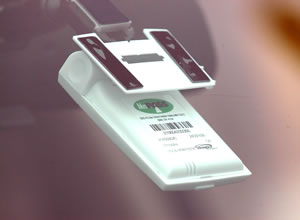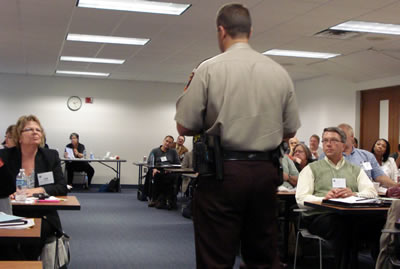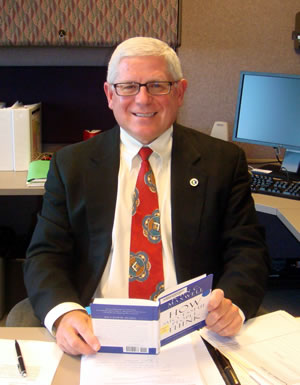 |
|

|
|

|
 |
TABLE of CONTENTS
 |
Mn/DOT to begin $50 million flood mitigation program |
Mn/DOT announced Oct. 19 a $50 million flood mitigation program for highway improvement projects that will make state roadways more resistant to future flood damage. These dollars, coupled with the Federal Highway Administration Emergency Relief to repair damage caused by September flooding, will improve state infrastructure now and in the future.
The program is not part of legislation coming out of the state Legislative Special Session on Oct. 18.
“As stewards of Minnesota’s infrastructure, we continuously look for enhancements that encourage sustainability while enhancing our quality of life,” said Tom Sorel, Mn/DOT Commissioner.
Mn/DOT will fund the mitigation program with $50 million of existing bond authority, $10 million each year through 2016. The agency has sufficient bonding authority and is experiencing cost savings on construction projects from recent bids.
The Transportation Program Investment Committee will develop criteria to prioritize projects across the state, according to Sue Mulvihill, Operations Division director. Districts will be asked to rank projects that fit the criteria. The first solicitation for projects will be in January 2011, with the next solicitation coming in fall 2011.
Examples of mitigation projects that will be funded include repairs to culverts in poor condition; improvements to drainage structures, slopes, berms and ditches prone to flooding; and repairs or flood mitigation projects on highways that regularly flood, such as Hwy 169, Hwy 59/Hwy 212, Hwy 41, Hwy 75, Hwy 101, Hwy 41 and Hwy 1. The efforts will also address basin flooding issues in the Red River Valley area of Minnesota.
Sorel said the program will mean lower costs to repair damage from future floods, creating a more sustainable transportation in the future. It will also provide more value and safer communities to Minnesotans with reduced repair costs and less traffic disruption.
2010 second special session provides flood relief
By Erik Rudeen, Office of Government Affairs
 The Legislature unanimously approved more than $80 million in assistance for September floods and spring severe weather during a brief special session on Monday, Oct. 18. Gov. Tim Pawlenty signed the bill into law the same day. The Legislature unanimously approved more than $80 million in assistance for September floods and spring severe weather during a brief special session on Monday, Oct. 18. Gov. Tim Pawlenty signed the bill into law the same day.
Local roads and bridges received $10 million in general fund bonding, while Mn/DOT received $5 million from the trunk highway fund for infrastructure operations and maintenance. The department can also draw on $5 million in trunk highway funds for emergency relief appropriated during the regular session. Some transportation facilities that were damaged are eligible for a portion of the $12 million appropriated to the Department of Public Safety, in addition to being eligible for federal assistance.
The legislation also clarifies that “expenditures for repair or replacement of flood damaged infrastructure are exempt from” the restriction on Chapter 152 bonds spent in Mn/DOT District 7. Photo by David Gonzalez |
|
 |
|

|
 |
TABLE of CONTENTS
 |
Mn/DOT reaches 20,000 transponders distributed for MnPASS Express Lanes |
|
By Chris Krueger

The five-year-old MnPASS program this month reached its 20,000 transponder distributed to users of the toll Express Lanes on I-394 and I-35W in the western Twin Cities metro area. .Mn/DOT file photo |
A couple of new customers on the MnPASS Express Lanes received $25 in toll credits after pushing Mn/DOT over the 20,000 mark for the number of transponders distributed for the Interstate 35W and Interstate 394 toll lanes.
Kim Iacarella, Burnsville, and Kathi Moter, Plymouth, received an additional $15 in toll credits MnPASS was offering to all new accounts until the end of the year.
“Kim and Kathi, and many other motorists see value in the congestion-free travel, reliability and safety that the MnPASS Express Lanes offer,” said Nick Thompson, MnPASS project manager.
Approximately 14,500 transponders currently are being used primarily on the I-394 Express Lanes, while another 5,500 transponders are being used primarily on the I-35W lanes. A transponder is a small electronic device that is placed inside a solo driver’s vehicle. When the transponder is read by an overhead electronic device on the lanes, a modest toll is charged to a customer’s prepaid toll account.
The I-394 Express Lanes have been in operation since 2005, and the I-35W Express Lanes opened in September 2009.
“We have seen more accounts opening lately in response to the coming November opening of the Crosstown section, which will further enhance I-35W MnPASS Express Lanes travel by providing a continuous route on the lanes for area commuters,” Thompson said.
Iacarella agrees.
“I just started my ‘dream job’ and it’s critical to get to work on time. MnPASS will give me a reliable commute,” said Iacarella.
“I like the option to get to work on time when driving my car,” said Moter, who has used the MnPASS for free by riding her motorcycle. |
 |
|

|
 |
TABLE of CONTENTS
 |
TZD conference features best national, international practices for reducing traffic fatalities |

Sue Groth, TZD co-chair and Office of Traffic, Safety and Technology director, was one of the speakers at the 2010 Toward Zero Deaths conference held Oct. 25-26 in St. Paul. Photo by Michael McCarthy, Center for Transportation Studies |
By Bob Filipczak
The annual Toward Zero Deaths conference got a surprise visit from U.S. Senator Amy Klobuchar during its opening session on Oct 25.
Klobuchar spoke about her efforts to make the nation’s roads safer through legislation, including fighting distracted driving caused by text messaging—something that hits close to home now that she is the mother of a 15-year-old who’s learning to drive. In addition, Klobuchar thanked the participants for their efforts to reduce traffic fatalities through enforcement, engineering, education and emergency and trauma services.
This year, the two-day event attracted a record 750 participants, including representatives from state government, city and county engineers, law enforcement officials, emergency management and public health professionals, and child passenger safety advocates.
“The TZD conference highlighted the great success that Minnesota has had in driving down fatalities through the efforts many, many partners,” said Sue Groth, TZD co-chair and Office of Traffic, Safety and Technology director.
Chuck Hurley, recently retired CEO for Mothers Against Drunk Driving, spoke about his vision for eliminating all drunk driving through use of technology. He described promising devices that could be installed in all vehicles—the cost being offset by reduced insurance rates—that would make it impossible to drive if the driver is over the legal blood alcohol limit.
“Some are driven by dollars and cents, and some of us are driven by blood and tears.”
~ State Senator Steve Murphy, about legislators’ motivations around traffic safety |
The TZD conference was followed by a workshop attended by 150 people that featured a delegation from Sweden. The country is known internationally for its groundbreaking work in traffic safety and has been working to drive down traffic fatalities and serious injuries since the mid-1930s. Minnesota’s TZD efforts were originally modeled on the Swedish “Vision Zero” program.
Some of the innovations Swedish presenters talked about include:
- 2+1 roads—This is an alternative to building four-lane, divided highways. These roads feature two lanes, intermittent passing lanes in the middle of the road, and a cable median barrier right down the center of the road. This cost-effective innovation has reduced fatalities by 90 percent on the roads where they’ve been installed.
- Speed enforcement—Sweden combines strict speed enforcement with an extensive network of automated cameras to catch speeders. It’s also looking at technology that could be installed in cars that could warn you when you’re exceeding the speed limit and that make it more difficult to push down on the accelerator when you get past a certain speed.
- Rear-facing child safety seats—Sweden has a law that requires child safety seats to be rear-facing. This has reduced traffic fatalities among children by 90 percent.
- Whoa!—When the Volvo representative showed a video of the distracted driver heading for the pedestrian in the crosswalk, there was an audible exclamation in the audience when the car stopped on its own. Volvo is experimenting with cars that have extensive safety features engineered right into the vehicle.
“Meeting with the Swedish Transport Administration, following the conference, gave us a glimpse of how much further we could go toward reducing deaths on our roads—both in Minnesota and in the United States as a whole,” Groth said.
To view the video Mn/DOT produced for the conference, see: The Faces of Impaired Driving.
For more information about the conference, see http://www.minnesotatzd.org/events/conference/2010/index.html.
For information about Minnesota’s Toward Zero Deaths, see http://www.minnesotatzd.org/. |
 |
|

|
 |
TABLE of CONTENTS
 |
Symposium prepares employees to protect themselves from potential workplace violence |
By Beth Petrowske

Lt. Eric Roeske takes questions from participants at the Workplace Violence Prevention and Response Symposium on Oct. 18. The focus of his presentation was an active shooter incident that took place during a Morrison County Board meeting in Little Falls. Photo by Beth Petrowske |
Mn/DOT has a zero tolerance violence policy and most employees abide by it. Those who don’t can be abusive and sometimes dangerous. Details about some of these violent incidents were reported by Mn/DOT districts during a Workplace Violence Prevention and Response Symposium on Oct. 18 at the Arden Hills Training Center.
About 90 Mn/DOT employees attended the day-long symposium designed to equip them with the information they need to detect behaviors that could potentially lead to violence. They also learned what to do if they are present when a life-threatening situation involving an active shooter arises.
“Mn/DOT employees should feel safe at work,” said Sue Mulvihill, Operations Division director and Violent Incident Advisory Team champion. “It’s impossible to protect against everything but if employees are trained, they will have a better chance of surviving a violent attack.”
Presenters Tracy L. Worsley, emergency preparedness manager, Minnesota State Colleges and Universities, and State Patrol officers Lt. Eric Roeske and Sgt. Dan Lewis used dramatic videos to teach important personal safety techniques and emphasize the importance of being prepared.
Worsley’s presentation focused on recognizing and preventing workplace violence.
“You are responsible for your own survival plan,” said Worsley. “We all need to be aware of our surroundings and be ready to take action.”
Worsley explained how to recognize “behaviors of concern” that sometimes lead to physical violence. These behaviors include threats, actions that negatively affect a co-worker’s physical or psychological well being, and causing damage to business property.
“If you observe a change in a co-worker’s demeanor and they become disruptive, aggressive, hostile or emotionally abusive, you should report this to your supervisor or someone in human resources. Reporting this behavior does not mean you’re a snitch or you’re causing someone to lose their job, it is the right thing to do for everyone’s safety, including the person you report,” Worsley said.
Mn/DOT policy requires employees to immediately report any physical violence or threats that they witness or are subjected to.
The focus of Lt. Roeske’s and Sgt. Lewis’s presentation was on a real workplace violence situation captured on video, involving an active shooter. The situation put several Morrison County Board members and law enforcement personnel in grave danger when a citizen took out a large handgun and threatened to execute each of the board members. Before he could accomplish his goal, the gunman was killed by police gunfire.
“This video made me realize how vulnerable we all are,” said Pam Tschida, Employee and Corporate Services Division director. “The shooter had been denied permit requests by Mn/DOT and he called a Mn/DOT employee to voice his frustration; this employee was as vulnerable to attack as the county board members were.”
Tschida strongly supports providing training of this type to all employees and has begun discussions to develop a training plan.
The symposium concluded with Mn/DOT district and office updates during which each area described a violent or potentially violent incident that occurred in the past year and how it was handled.
“The Violent Incident Advisory Team has already begun discussions about creating a plan to roll out this type of training agencywide,” said Lucy Kender, Human Resources project manager and VIAT co-chair. “VIAT well understands the importance of raising awareness on this issue and will move quickly to get the training plan developed.”
More information on Workplace Violence Prevention as well as materials from the recent symposium are available on the Workplace Violence Prevention website.
|
 |
|

|
 |
TABLE of CONTENTS
 |
Commissionerís next book discussion set for Nov. 3 |

Tom Halverson, chief financial officer, will lead the Commissioner’s Reading Corner book discussion Nov. 3. Photo by Qin Tang |
Employees interested in attending the latest Commissioner’s Reading Corner discussion can still sign up at ihub/readingcorner/index.html. Tom Halverson, chief financial officer, will lead a discussion of “How Successful People Think: Change Your Thinking, Change Your Life,” by John C. Maxwell.
The discussion will take place Wednesday, Nov. 3, at 1:30 p.m., in Central Office Conference Room 461. Employees can also participate virtually via Adobe Connect and should log in as a guest no earlier than 1:15 p.m. All employees are encouraged to attend, even if they have not yet read the book, according to Qin Tang, Mn/DOT librarian.
Employees can also prepare for future book discussions by checking out other titles on the reading corner book list, which includes “Crucial Conversations: Tools for Talking When the Stakes are High,” by Kerry Patterson. Khani Sahebjam, deputy commissioner/chief engineer, will lead a discussion of that book Dec. 1.
Other upcoming discussions will include these titles, which are available in the Commissioner's Reading Corner at the Mn/DOT Library:
- A New Breed of Leader: 8 Leadership Qualities that Matter Most in the Real World: What Works, What Doesn't, and Why
- The Trusted Leader: Building the Relationships that Make Government Work
- The 21 Irrefutable Laws of Leadership: Follow Them and People Will Follow You
- Collaborative Leadership: How Citizens and Civic Leaders Can Make a Difference
- Jeffrey Gitomer's Little Teal Book of Trust: How to Earn It, Grow It, and Keep It to Become a Trusted Advisor in Sales, Business & Life
Employees with questions can contact Rebecca Fabunmi, special assistant to the commissioner, at 651-366-4808. To read an interview featuring Halverson’s take on the latest book, visit ihub.dot.state.mn.us/readingcorner/interviews.html.
|
 |
|

|
 |
TABLE of CONTENTS
 |
SPOT, Ombudsman programs receive National Partnership for Highway Quality awards |
By Beth Petrowske
 The efforts of Deb Ledvina, transportation ombudsman, and her staff were recognized by the National Partnership for Highway Quality for the ombudsman function's innovation and focus on continuous improvement. The efforts of Deb Ledvina, transportation ombudsman, and her staff were recognized by the National Partnership for Highway Quality for the ombudsman function's innovation and focus on continuous improvement.
Commissioner Tom Sorel established the position of transportation ombudsman two years ago to serve as a resource for citizens who have a conflict that they have been unable to resolve using standard methods. Mn/DOT file photo by Craig Wilkins |
The National Partnership for Highway Quality awarded Mn/DOT two silver awards for its Ombudsman Office services and its Snow Plow Operator Training Program. Both won in the “Making a Difference” category.
NPHQ award winners must demonstrate improved quality or customer service related to highway planning, project delivery, highway maintenance, safety, congestion management, workforce training, environmental stewardship or highway operations.
Mn/DOTs Ombudsman Office was established in 2008 to serve as a resource for citizens who have a conflict that they have been unable to resolve using standard methods. Ombudsman Office staff works with citizens to find fair and consistent solutions. Resolution can range from education about the issue and Mn/DOT policy and processes to making a change in a Mn/DOT policy because it creates unintended effects.
“Listening is a key component to good leadership. It is critical that Mn/DOT listen to what the public has to say,” said Mn/DOT Commissioner Tom Sorel. “The ombudsman offers citizens an excellent alternative when other routes are not satisfactory. We are pleased with the recognition this award provides, but are more pleased with the fact that we are better able to serve the public using the ombudsman’s efforts.”
Mn/DOT developed SPOT to provide consistent, up-to-date training for all new Mn/DOT commercial motor vehicle drivers. The curriculum includes training on safety, plowing techniques, new equipment and procedures related to winter highway maintenance operations. Training includes classroom instruction and field exercises where trainees hone their snow plow driving skills.
“Mn/DOT puts a high priority on making our roads safe for motorists,” said Deputy Commissioner Khani Sahebjam. “Our Snow Plow Operator Training Program is one of the reasons we continue to improve our snow and ice removal operations.”
NPHQ is a national coalition of public highway agencies, industry organizations and private firms founded in 1992 as the National Quality Initiative. For more than 15 years, NPHQ has brought public highway agencies and private industry together to lead the advancement in highway quality, safety and service to the highway users. For more information on the NPHQ and its awards program, visit: www.nphq.org.
To learn more about Minnesota's Snow Plow Operator Training Program, visit: www.dot.state.mn.us/ or Mn/DOT Ombudsman's Office, visit: www.dot.state.mn.us/ombudsman. |
 |
|

|
 |
TABLE of CONTENTS
 |
Cyber security: Knowing whatís real and whatís not |
By Linda Dahlen, chief information security officer

Linda Dahlen is Mn/DOT's chief information security officer. Photo by Beth Petrowske |
To me and my peer group of state agency information security officers, it often seems like cyber security is an oxymoron and cyber insecurity is the norm. The “bad guys”—thieves, imposters and even terrorists—are relentless in their attempts to steal, manipulate, destroy and prevent us from using the data we need to serve the people of Minnesota.
October is National Cyber Security Awareness Month, a time for us all to be aware of risks associated with unsafe online behavior and become reacquainted with safe e-mail practices.
By far, the hardest thing to control in cyber security is the human factor. Human beings can be hurried and are inattentive at times, which can result in the opening of fake trap messages that look real.
This summer, for example, the department received notice from the Office of the Attorney General for the state of Washington that a Mn/DOT computer was flooding their mailboxes with spam e-mail messages. Upon investigation, we found that a Mn/DOT employee had clicked on a link in a fake “your mailbox is full” message. When that happened, it provided the opportunity for the bad guys to add a program to the computer, which converted the machine to a spam generator. In addition, the employee lost all saved e-mails and had some data affected.
Last month, the state of Minnesota e-mail system received more than 304 million spam e-mail messages. More than 57,000 contained viruses or infected attachments. Even with the continuous development of defense strategies, firewall technologies, and authentication techniques like usernames and passwords, the bad guys will continue to try to sabotage our efforts. For this reason, all of us must work together to avoid harmful situations.
I know—passwords annoy me, too. Maybe someday we will add biometrics, iris scans or thumbprints to the security process. Until that day, however, you can find a number of useful tips for keeping your data—and Mn/DOT’s—secure on the Office of Information and Technology Services website.
Cyber security crosses the boundaries of many functional units in Mn/DOT. I work with some fabulously knowledgeable techie people but I am also privileged to work with Mn/DOT employees in records management, data practices, human resources, communications, Policy Analysis, Research and Innovation, construction, maintenance, and many other areas. I am so appreciative of the attention these employees pay to cyber security and the willingness to include it in their work processes and products.
Individual employees often contact me with questions about how to handle specific e-mail messages or to share information on new threats or to offer suggestions. To each one of you who does this, I appreciate your vigilance.
If you watch the “Red Green Show” on public television, you know that a segment always ends with “We’re all in this together.” And in cyber security, so we are.
It’s a trap!
In an infamous sting a few months ago, information technology security professionals created a fake Facebook page for a young and attractive female with a background in IT in the Washington, D.C., area.
You guessed it: security professionals fell all over themselves to correspond with “her.” They even engaged in communication that could have put sensitive information at risk. All this happened because they ignored obvious warning flags, like “her” claim to have 10 years of IT work experience while in her early ‘20s.
Lesson learned? We all need to be vigilant about our computer security habits—even computer security experts. |
Key numbers from September 2010
- Messages sent to state mail system: 314,011,859
- Messages delivered to state mail boxes: 9,560,707
- Messages destroyed as spam: 304,393,430
- Viruses destroyed: 49,328
- Illegal attachments blocked: 8,394
- Percentage destroyed: 97%
|
|
 |
|
| |
|



